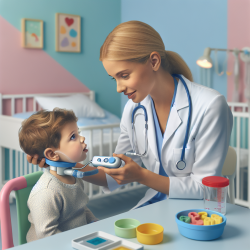Introduction
In the realm of speech-language pathology, the quest for innovative solutions to enhance patient care is relentless. A recent study titled "The effects of head movement on dual-axis cervical accelerometry signals" sheds light on a crucial aspect of medical device development for swallowing disorders. This research offers valuable insights that can be harnessed to improve therapeutic outcomes for children, particularly those with dysphagia. In this blog, we will explore the implications of this study and how practitioners can leverage its findings to refine their skills and deliver better care.
Understanding Cervical Accelerometry
Cervical accelerometry is a non-invasive technique that involves attaching an accelerometer to a patient's neck to assess swallowing disorders. Traditionally, single-axis accelerometers were used, but recent advancements have shown that dual-axis accelerometers provide more comprehensive data. This is particularly important in pediatric care, where precise diagnosis and monitoring are critical.
Key Findings from the Study
The study conducted by Sejdić, Steele, and Chau focused on the impact of head movements on dual-axis cervical accelerometry signals. The researchers found that:
- Peak frequencies are independent of head motion type, participant gender, and age.
- Spectral centroids differ significantly between anterior-posterior (A-P) and superior-inferior (S-I) directions and among different head motions.
- Bandwidths vary for head tilts down and back between the A-P and S-I directions.
These findings highlight the importance of considering head movements when developing medical devices based on dual-axis cervical accelerometry signals.
Implications for Practitioners
For practitioners, these insights offer several actionable takeaways:
- Refinement of Diagnostic Tools: By understanding the effects of head movements, practitioners can refine diagnostic tools to improve accuracy in detecting swallowing disorders.
- Customized Treatment Plans: Knowledge of how head movements influence accelerometry signals can guide the customization of treatment plans, ensuring they are tailored to each child's unique needs.
- Enhanced Device Development: The study's findings can inform the development of more sophisticated medical devices that account for head movements, gender, and other demographic factors.
Encouraging Further Research
While this study provides a solid foundation, it also opens the door for further research. Practitioners are encouraged to explore additional variables that may affect cervical accelerometry signals. This could include investigating the impact of different postures or movements specific to pediatric populations.
Conclusion
The study on the effects of head movement on dual-axis cervical accelerometry signals offers valuable insights that can significantly enhance pediatric care. By integrating these findings into practice, speech-language pathologists can improve diagnostic accuracy and treatment outcomes for children with swallowing disorders. For those interested in delving deeper into the research, the original paper can be accessed here: The effects of head movement on dual-axis cervical accelerometry signals.










